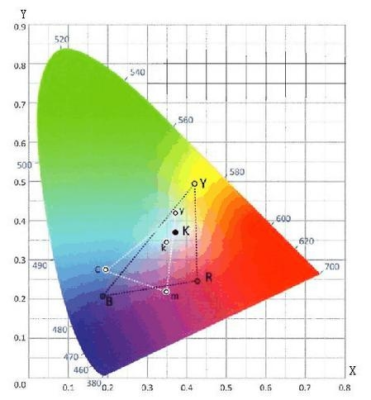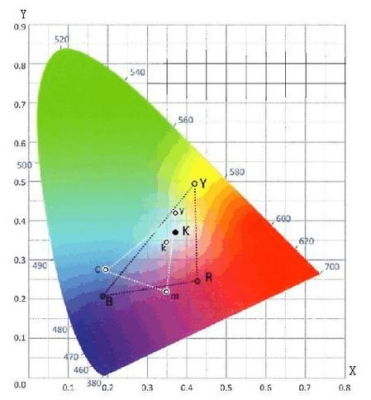Colorimeter is an instrument developed according to color characteristics to detect color difference. This instrument simulates the way the human eye perceives color, and uses precise calculation to obtain color information. At the same time, according to the color information, we can analyze the color trend, and finally determine the color adjustment method to achieve the goal of color control.
Colour
In our daily life, we are exposed to a variety of colors, and it is these different colors that make our world colorful. However, we may not have considered how these colors are formed? In fact, the answer is very simple: the interaction between light, objects and the observer produces color. The specific process is that light is perceived in the form of color when it arrives at the observer’s visual system through the object. From this, we can see that light, object and observer are the basic elements to produce color. First, let’s study the origin of color – light.
Light – wavelength and visual spectrum
Our eyes have sensors that are sensitive to visible light. They send the detected signals to the brain. The signals detected by the brain through analysis and judgment are sent to the brain. The brain generates a sense of color through analysis and judgment. When a beam of white light is scattered through a prism, our eyes can see the wavelengths after light splitting, and our eyes can see the wavelengths after light splitting. We can identify the red, orange, yellow, green, blue, and purple in the visible spectrum, as well as the rainbow bands they form. When our vision system detects the wavelength of about 700nm, we see “red”; 400nm wavelength gives us the feeling of “purple” and so on. Our vision system can detect hundreds of millions of different colors every day.
However, it is difficult to see all wavelengths (pure white light) at the same time, and it is also difficult to see a single wavelength. Our color world is much more complicated than this. It can be seen that color is not a simple part of light, but a new combination of many wavelengths after the change. For example, when we see a red object, the light we detect mainly contains the “red” wavelength. In this way, all objects get their color by changing the light.
Object – wavelength manipulation
When the light shines on the object, the surface of the object absorbs some spectral energy, and the spectral energy of other parts is reflected by the object. The reflected light has a new wavelength composition. Different surfaces show different colors – this is because they have different reflectivity to different wavelengths. The spectral data can be obtained by measuring the reflectivity corresponding to each wavelength. This spectral data can be plotted into a spectral curve, which is the most accurate description of color.
Observer – perceive wavelength as “color”
Human vision is the eye to light sensor network. These sensors transmit the response signals of different wavelengths to the brain, where these signals are processed into perceptible colors. Our memory system can recognize different colors and then match them with colors of a certain name. The human visual system uses very effective methods to process a large number of wavelengths, and divides the visible spectrum into the main red, green, and blue components, and then uses them to calculate color information.
Factors affecting human observation of color
Subjective feelings, emotions, physical health, background.
Color space – drawing color stereo
The so-called color space is a three-dimensional space based on the coordinates of the elements describing the color. The color space can be used to describe the color range of vision or the color gamut of measuring instruments and equipment. In the color space, each color has a unique set of parameters corresponding to it, and each set of parameters also corresponds to a unique color, so that we can use a quantitative data to represent the color, making it possible to digitize the color quality control.
In 1931, CIE (International Committee for Standard Lighting) established a series of representations
Color space standard of visible spectrum. The basic CIE color space standard is CIE XYZ, which is based on the visual ability of the standard observer – that is, it reflects the standard range of colors visible to the human eye. Based on CIE XYZ, there are CIE xyY, CIE Lab, CIE Lch and other standard color spaces. At present, CIE Lab color space is most commonly used in the industry. The CIE Lab color space uses L value to represent the brightness of the color, a value to represent the green and red value of the color, and b value to represent the blue and yellow value of the color. It is of little practical significance to judge a color simply by a set of Lab values, but when we can judge the difference between the two colors by their Lab difference.
Color difference
L represents lightness, that is, color depth, a represents red green value, and b represents yellow blue value.
If L is “+”, it means the color is lighter, and if L is “-“, it means the color is darker.
A “+” means the color is red or less green, and “-” means the color is green or less red.
B “+” means the color is yellow or less blue, and “-” means the color is blue or less yellow.
△ E represents the color difference. Users can set the allowable color difference value according to their own needs.
Future development trend of colorimeter:
Intelligence
With the rapid development of science and technology, the use of new materials, color difference instruments combined with microprocessors and computer testing software can achieve more accurate, more reliable and more functional color detection and analysis functions. At the same time, the calculation speed, induction sensitivity and analysis comprehensiveness have been improved, which makes the color difference instrument more humanized and intelligent.
Accurate and high-speed
For the performance improvement of micro processing and sensors, more advanced algorithms should be embedded in color detection, which can realize color detection in more products and environments faster and more accurately. With the innovation of materials and the development of technology, higher precision light sources and sensors can be used, and the speed and accuracy of measurement will be better and better.
Stability of measurement
Most of the color difference meters designed and developed in China now use photodiodes as sensors. With the development of science and technology, semiconductor technology and the advancement of coating technology, the future domestic color difference meters may gradually realize the addition of semiconductors, coating processes and efficient algorithms to ensure the measurement accuracy and stability of color difference meters.
Portable appearance
Large colorimeter is very troublesome and inconvenient in the process of measurement and handling. Color difference instruments, such as small size, full function, high accuracy and good stability, which can measure a variety of products, are the standard of color detection instruments widely required by future manufacturers.
Realize the conversion of multiple color spaces
The color detection standard realized by different chromaticity spaces is that the environment of use and measurement is different. In order to achieve more color measurement, the future color difference meter may realize the mutual conversion of CIERGB, CIEXYZ, CIELAB, CIELCH, HunterLAB, providing users with more test parameter choices.

CIEXYZ color space

CIELAB color space
PC computer expands the functions of the colorimeter
This function may be a function that all instruments in the future should have. It will become a trend to use color difference instruments on computers in the information and scientific era.
LISUN lauched Portable Colorimeter/Chroma Meter is an innovation color measuring tool with powerful configuration to make color measurement easier and more professional; It support Bluetooth to connect with Android and ISO devices, Portable Colorimeter/Chroma Meter will take you into a new world of color management; It can be widely used to measure color value, color difference value and find similar color from color cards for printing industry, paint industry, textile industry, etc.
Lisun Instruments Limited was found by LISUN GROUP in 2003. LISUN quality system has been strictly certified by ISO9001:2015. As a CIE Membership, LISUN products are designed based on CIE, IEC and other international or national standards. All products passed CE certificate and authenticated by the third party lab.
Our main products are Goniophotometer, Integrating Sphere, Spectroradiometer, Surge Generator, ESD Simulator Guns, EMI Receiver, EMC Test Equipment, Electrical Safety Tester, Environmental Chamber, Temperature Chamber, Climate Chamber, Thermal Chamber, Salt Spray Test, Dust Test Chamber, Waterproof Test, RoHS Test (EDXRF), Glow Wire Test and Needle Flame Test.
Please feel free to contact us if you need any support.
Tech Dep: Service@Lisungroup.com, Cell/WhatsApp:+8615317907381
Sales Dep: Sales@Lisungroup.com, Cell/WhatsApp:+8618117273997
Your email address will not be published. Required fields are marked *